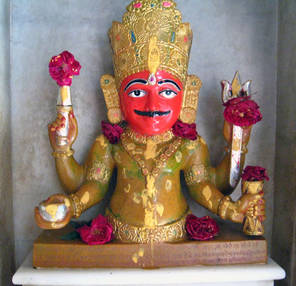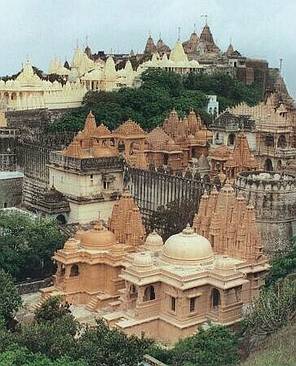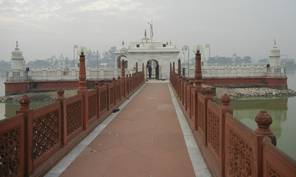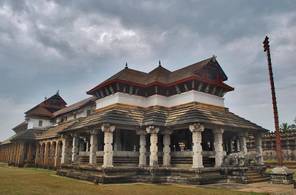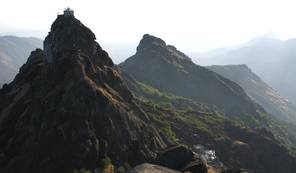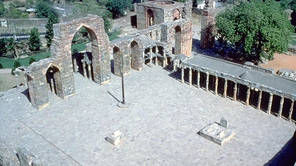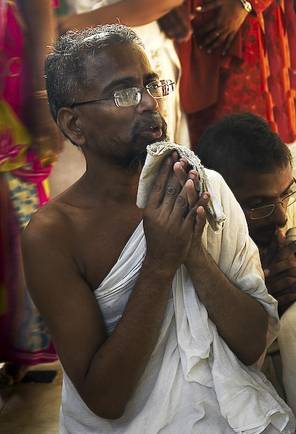Article: Jain holy places
In principle Jain holy places are sacred for all the Jains. In practice, some places are definitely of more importance to Śvetāmbaras than to Digambaras and vice versa, and these are managed by institutions affiliated to one sect or the other. History and contemporary information provide evidence of competition and quarrels between the sects over the management of individual sites. This is because a sacred place is an expression of a community’s presence and therefore a political issue.
A sacred place is known as a tīrtha. This Sanskrit word, used in modern languages as well, originally meant a ford across a river or a flight of steps used to descend into water. It then came to mean a holy place because of the purifying character of water. In Hinduism many sacred places are connected with water and rivers. Jains, however, reject any definition of purity as an external thing, linked to water or bathing. So they have redefined the concept of a holy place, as they have done with many other Indian notions. Instead, Jains highlight the spiritual meaning of the word – a tīrtha is any place that has become holy because of its association with Jinas or Jain values. The tops of hills or mountains are often holy places to Jains and therefore frequently pilgrimage destinations. The main attraction of these places is sometimes a unique statue, more often a temple or, in many cases, clusters of temples. Several prominent Jain tīrthas, such as Mount Śatruñjaya – more commonly known as Shatrunjaya or Mount Shatrunjaya – have so many temples they are effectively temple-cities.
A Jain mendicant is often said to be a ‘moving tirth’ – jangama-tīrtha. This is the only type of tīrtha that has real value for those Jains who are against the worship of images, such as the Śvetāmbara Sthānaka-vāsin.
The importance of individual holy places has varied over history. Some ancient sacred places are still popular today and have usually been renovated and developed. Others were once vibrant with religious activity but are now protected archaeological sites, visited by followers and tourists alike. Though they are still sacred in the minds of Jains, this sanctity is now separate from active worship. In medieval times totally new tīrthas emerged in the religious landscape. Today others are becoming prominent and completely new ones are being created, especially outside India in countries where the Jain diaspora has settled.
Why is a place holy?
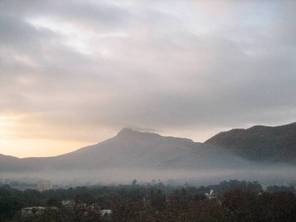
Mount Girnar in the mist
Image by Dhwani Bhatt © CC BY-SA 3.0
Jains often distinguish between two kinds of sacred places:
- where someone reached final liberation – siddha-kṣetra
- where any remarkable event took place – atiśaya-kṣetra.
The concept of siddha-kṣetra is crucial in Jain thought in defining a holy place. However, material items such as relics or remains of any kind are not important in thinking of a place as holy in Jain belief and practice. This attitude is in tune with the definition of liberated beings – siddhas – as pure souls.
A remarkable event – atiśaya-kṣetra – that causes Jains to hold a place sacred could be a miracle or the presence of any guardian deity or powerful image.
Holy places vary in size from small isolated spots to the large temple-cities built on mountains. Probably the best-known Jain temple-cities are those of Shatrunjaya and Girnar.
Sacred places are infused with multiple meanings and memories of mythical events. The sanctity is translated into various forms, including footprints, temples and images. But it also resides in elements of the landscape, with specific ponds, stones and trees often seen as holy. They are connected to certain episodes that are transmitted in oral and written form. In this way, some holy places such as Shatrunjaya are ascribed almost supernatural powers, including the power to cure illness. A pilgrimage is complete when it involves a tour of all the sacred spots found in a holy place.
The Jinas

Twenty Jinas
Image by British Library © CC0 1.0 (Creative Commons Public Domain)
Considering the central importance of the Jinas in Jainism – as the ultimate source of knowledge, teachings and behaviour – it is not surprising that most holy places are closely associated with them. Most are locations where events in the Jinas’ lives occurred. The traditional dates of these events given in scriptures form the basis of the religious calendar and festivals. Even today Jains are well aware of such links with the past.
Before reaching omniscience, the Jinas were part of the cycle of rebirths. All of their lives show a similar pattern. In the standard account of their lives, of which Hemacandra’s 12th-century work can be considered representative, there is a set of five events. These ‘auspicious events’ – pañca-kalyāṇakas – are at the centre of worship:
- conception – cyavana
- birth – janma
- initiation into monastic life – dīkṣā
- enlightenment – kevala-jñāna
- final liberation – nirvāṇa or mokṣa.
Any place connected with any of these events is potentially holy. The foremost sites, however, are those where the Jinas were born and those where they reached liberation. Sites where more than one such event took place are traditionally called kalyāṇa-kṣetras – ‘places of auspicious events’.
|
Holy place |
Auspicious event |
|
|---|---|---|
|
Aṣṭāpada, legendary mountain |
liberation |
|
|
Ayodhyā |
birth |
|
|
Banaras |
birth |
|
|
Bhadrilapura |
birth |
|
|
Candrānana |
birth |
|
|
Campā = modern Bhagalpur, Bihar |
birth and liberation |
|
|
Girnār, Gujarat |
renunciation, omniscience and liberation |
|
|
Hastināpura or Hastinapur, Uttar Pradesh |
birth |
|
|
Kākandī |
Suvidhi |
birth |
|
Kāmpilya |
birth |
|
|
Kauśalya |
birth |
|
|
Kauśambī |
birth |
|
|
Kuṇḍapura (see Brekke 2003) |
birth |
|
|
Mithilā |
birth |
|
|
Pāvāpurī, Bihar |
Mahāvīra |
liberation |
|
Rājagṛha = modern Rajgir, Bihar |
birth |
|
|
Ratnapura |
birth |
|
|
Sammet Shikhar, Jharkhand |
20 Jinas |
liberation |
|
Siṃhapura |
birth |
|
|
Soriyanagara |
Nemi |
birth |
|
Śrāvasti |
Sambhava |
birth |
|
Vinītā |
birth |
Several names in this list are also where one Jina or another received proper alms for the first time after a long fast – Ayodhyā, Śrāvastī, Hastināpura, Mithilā and Rājagṛha. More generally, they owe their sanctity to their association with several events, all recorded in specialised works.
Other mythical figures
Places where holy figures of the Jain tradition have attained final liberation are also potential sacred sites.
Mount Shatrunjaya in Gujarat is also called Puṇḍarīka Mountain because it is said that Puṇḍarīka, the first chief disciple of the first Jina Ṛṣabha, attained liberation there.
This is also where Rāma, Sītā, the Pāṇḍava brothers and their mother Kuntī were emancipated from the cycle of rebirth.
Religious teachers
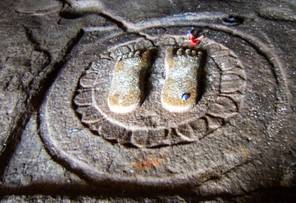
Bhadrabāhu’s sacred footprints
Image by Ilya Mauter © CC BY-SA 2.5
A place that is traditionally associated with the birth or liberation of a religious teacher is also considered holy and often develops into a pilgrimage site. There are examples of this phenomenon for both teachers in the distant past and more recent ones. Their presence takes material form in items such as footprints – pādukā – shrines or memorials of any kind.
Ponnur Hill, in Tamil Nadu, is the place where the early Digambara teacher and author Kundakunda is said to have reached liberation. Footprints have been carved in the rock and are worshipped.
Several Jain temples are found in Ladnun in Rajasthan. It has become a specially sacred place for Terāpanthin Jains in the 20th century because it is the birthplace of Ācārya Tulsī, eighth leader of the sect, who was chief monk for over 60 years.
About 20 kilometres from Delhi is the ‘Vallabh Smarak’ or Memorial to Ācārya Vijayavallabha-sūri. It has become a sacred place, and a temple enclosure has been built there.
Jina images
Several holy places are associated with the local image of a Jina. This link is often clear in their names, such as Sankheshwar-Parshvanath, Phalodi-Parshvanath and Jiravala-Parshvanath, which are all connected to the 23rd Jina, Pārśvanātha or Lord Pārśva.
Such images are considered holy because of their miraculous powers and the often extraordinary circumstances in which they were discovered or, rather, rediscovered. The stories of rediscovery underline that the statues had been there for a long time but were buried in the ground, at the foot of a tree and so on. The idol’s presence was revealed through the dream of a follower, the spontaneous lactation of a cow or other such phenomenon. When the image was found, it was ritually installed and became the focus of a holy place where the whole community came to worship. This type of account is found especially among the Śvetāmbara Mūrti-pūjak Jains. An example is Jinaprabha-sūri‘s collection, Vividhatīrtha-kalpa, which dates back to the 14th century. These tales may refer indirectly to historical events or, at least, the adventures of old Jina statues that survived the Muslim destruction of religious images during the medieval period.
Local gods
Some of the Jain holy places are considered sacred because of their association with figures that are neither Jinas nor religious teachers. Strictly speaking, Jains do not worship deities. Jinas are neither gods nor able to interfere in worldly affairs because they have attained liberation – believers honour their examples in worship. However, offerings are frequently made to the Jinas’ spiritual attendants, the yakṣa and yakṣī, who can play a part in human lives. Many Jains also make offerings to Hindu gods such as Gaṇeśa or Śrī. The increasingly popularity of Jain pilgrimages to places that are not associated with Jain religious tradition is awakening the interest of anthropologists as it shows original combinations of mainstream Jainism and other trends.
There are two good examples of this phenomenon. For centuries Nākoḍā in Rajasthan has been associated with a black idol of Pārśvanātha or Lord Pārśva, which was rediscovered and established in the temple in the 15th century. Over time the popularity of this site faded until it was revived through the efforts of a Jain nun at the beginning of the 20th century. It has now regained some of its former eminence thanks to its focus on the cult of the Nākoḍā Bhairava. This is a local image of Bhairava, who is a manifestation of Śiva. Recent ethnography shows that pilgrimage to Nākoḍā tends to be concentrated on this deity rather than on the Jina directly.
Similarly, Mahuḍī in Gujarat is a Jain tīrtha entirely dedicated to a god of a peculiar kind. Ghaṇṭākarṇ Mahāvīr is a ‘muscular, moustachioed male deity worshiped by Jains as a fellow Jain who can assist them within the worldly realm of wellbeing’ (Cort 2001: 165).
Visitors to such holy places form less homogeneous groups than pilgrims to traditional Jain tīrthas. The visitors may not be religious or even Jain at all. This is probably because these cults are essentially about worldly values. Jain pilgrimage sites of long standing usually focus on spiritual improvement.
Mythical sacred places
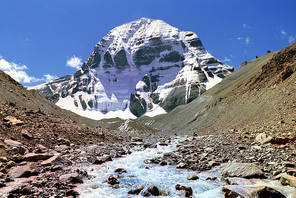
Mount Kailash
Image by reurinkjan © CC BY-NC-SA 2.0
Two places are considered holy by the Jains but are not part of ordinary geography.
The former is the legendary mountain where the first Jina Ṛṣabhanātha or Lord Ṛṣabha reached liberation. It is often identified with Mount Kailāsa in the Himālayas.
The second cannot be located on maps of India either, since it belongs in the category of cosmography. According to traditional cosmological theories, it is a continent in the human world but inaccessible to humans. Considered a holy place because it is a centre of worship, Nandīśvara-dvīpa has 52 temples in which the gods worship the Jinas.
Since these two holy places are vital parts of Jain sacred geography, they are treated on a par with other sacred places in literary descriptions. From the 12th century onwards, they appear in the visual arts as three-dimensional models or sculpted on temple walls.
Holy places in writing and song
Like Jinas and religious teachers, a Jain sacred place draws homage, devotion and praise from believers. Writings about holy places are seldom neutral and purely descriptive, as guidebooks usually are. Even the numerous booklets about individual sacred places published today do not just describe the physical place. Descriptions usually narrate all the legendary events or signs that create the meaning and sanctity of a holy place.
Texts about holy places can be grouped in three main ways:
- lists in verses
- kalpas and māhātmyas
- hymns of praise to sacred places or to a particular Jina image associated with a holy place.
Lists of holy places in longer poems are known as tīrtha-mālās – ‘garland of sacred places’. They show the expansion of Jain sacred geography in the accumulation of names. Some refer to well-known places while others are no more than names, often difficult to identify and locate.
The second group of texts – kalpas and māhātmyas – may be in either prose or verse and is a skilful cross of descriptions and legends. The most famous kalpa is the Vividha-tīrtha-kalpa or Pieces on Various Sacred Places, written in the 14th century by Jinaprabha-sūri, a Śvetāmbara monk belonging to the Kharatara-gaccha. The holy places Jinaprabha treats are primarily in western and northern India, though there are also a few in south India. The text includes sometimes detailed topographical descriptions, legends of the origin of the holy places and lists of the mythical events that took place there. It also notes disturbances that affected sacred places and religious images in the author’s time. The ruler of India at the time of writing was the Muslim Sultan Muhammad bin Tughlaq, whose 26-year reign was tumultuous and unsettled.
Māhātmyas celebrate the greatness of a holy place through associated legends, its various names and so on. Many of the māhātmyas are dedicated to Shatrunjaya, assuredly the paramount holy place for Śvetāmbaras.
The devotional songs referring to holy places either extol a place itself or the particular Jina image associated with it. The hymns are chanted on pilgrimages to these places or when models and paintings of the places are seen on daily visits to the temple.
Sacred places in visual art
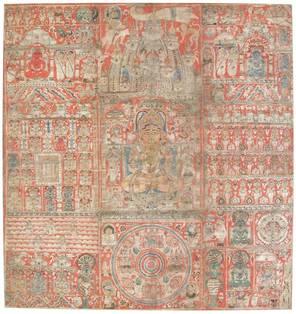
Worlds of gods and saviours
Image by San Diego Museum of Art © CC BY-NC-ND 2.0; Edwin Binney 3rd Collection
Holy places are thought of the proper destination of Jain pilgrimages. The most famous, especially those favoured by the Śvetāmbara sect, are a commonplace sight in many temples. They usually take the form of:
- bas-reliefs or sculptures on temple walls
- metal plaques or panels
- cloth-hangings on temple walls called paṭas
- mural paintings from all periods, including contemporary, in Śvetāmbara or Digambara temples.
Girnar, Shatrunjaya and Sammet Shikar are among those most frequently represented. But there are also paṭas featuring all sorts of holy places (Treasures of Jaina Bhaṇḍāras: 42).
The murals and cloth-hangings in particular are often detailed topographical maps showing all the sacred spots of a site, complete with captions. Still being created today by local artists, these pieces of art became more frequently made from the 17th century onwards.
One instance of relief carving is in a temple at Ranakpur, showing a combined representation of the temple-cities of Shatrunjaya and Girnar. It has stylised carvings of temples, standing Jinas, chariots and ponds. The peaceful atmosphere is symbolised by a snake and a peacock, which are normally natural enemies (Jain and Fischer 1978: plate XXXIb).
Depicting pilgrimage destinations is a way of guaranteeing the presence of these holy sites at all times and for all followers. On their regular visits to the local temple, worshippers perform a circumambulation. During this ritual walk around the sacred ground of the temple, they look at all the religious objects illustrated there. Mentally, they are transported to these sacred places by the sight of paintings or hangings of them (Jain and Fischer 1978: plate XXXIIa).
Importantly, the artworks are also surrogates for the physical journey of pilgrimage. All prescriptive texts consider this possibility for people who are ill, old or do not have the chance of taking a trip to distant places. In addition, pilgrimages are forbidden – or at least not encouraged – during the rainy season, for practical as well as religious reasons.
These paintings and hangings are also used during rituals or religious commemorations connected with these sacred places. Lay people sit in the temple hall and listen to the sermon of a mendicant, who shows the various holy spots linked to a given legend (Granoff, Victorious Ones: 276–281; Van Alphen: 128, figure 54 and pages 128 to 131; Hawon Ku 2007).
Geographical distribution of sacred places

Location of Mount Kailash
Image by University of Texas © CC-PD-Mark
There are Jain sacred places all over India and it is impossible to list all of them here. Several illustrated books published in India by various Jain organisations or managing trusts describe them by state. Titles such as Jain Sacred Places of India generally provide basic geographical and practical information, with a few photographs of the temples and their main images. A look at such publications shows how extensive the lists of holy places can be.
The distribution of religiously significant places on Indian territory is linked with historical factors and Jains’ periodic migrations or establishment of settlements.
The map of Jain sacred geography is continually changing, with hierarchies of temples and religious sites evolving over time. There are some places that boast local fame while others enjoy a supra-regional status and contribute to defining community identity.
Śvetāmbaras consider a group of five holy places – pañca tīrthas – to be the most prominent:
- Shatrunjaya
- Girnar
- Abu
- Sammeta Śikhara
- Aṣṭāpada.
In the medieval period, strategies developed to expand the circuit of pilgrimage sites and to promote new places, as older ones became inaccessible, or to call attention to fresh places and new celebrations.
Eastern India
The eastern part of India, especially that area corresponding to the modern states of Bihar and Jharkhand, was where Mahāvīra was born, lived and taught. Some important holy places are connected with events in his life and in the lives of other Jinas.
For example, Pāvāpurī is the small place where Mahāvīra died. Every year it becomes a vibrant pilgrimage site at the time of the Dīvālī festival, which commemorates Mahāvīra’s liberation. Sammet Shikhar – also known as Sammeta Śikhara – is the mountain where 20 out of the 24 Jinas attained nirvāṇa or mokṣa.
Western India
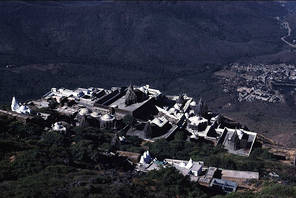
Temples on Mount Girnār
Image by peteranddorota © CC BY-NC-ND 2.0
Several places holy to the Jains, some of them globally famous, are found in western India, an area where Jainism has always flourished. The Śvetāmbaras are dominant here and many sites are associated with this sect.
The best known sacred places are:
- Mount Girnar
- Mount Shatrunjaya
- Mount Abu.
In eastern Gujarat, Mount Girnar is associated with Neminātha or Lord Nemi and is significant for both Śvetāmbara and Digambara sects.
Mount Shatrunjaya, near the village of Palitana in Gujarat, is considered the ‘king of sacred places’ – tīrthādhirāja – by the Śvetāmbaras. It is undoubtedly their most prestigious and famous tīrtha.
Found near the village of Delvara in southern Rajasthan, Mount Abu is famous for the marble temples erected there between the 11th and 13th centuries. This temple-city is an architectural jewel as much as a site of pilgrimage.
But there are many more holy sites in this part of India, such as Kumbharia, Taranga Hill, Sankheswhar, Kesariyaji, and Idar.
Delhi area
Hastinapur is a prehistoric site Jains consider holy because it is associated with events in the lives of four of the Jinas:
- Kunthunātha or Lord Kunthu
- Aranātha or Lord Ara
- Śāntinātha or Lord Śānti
- Ṛṣabhanātha or Lord Ṛṣabha.
Over the last 40 to 50 years Śvetāmbaras and Digambaras have developed it in different directions and now it occupies a prominent spot on the map of Jain religious geography. In recent decades it has become particularly well known as a Śvetāmbara destination for the Akṣaya-tṛtīyā celebration. Commemorating the fast-breaking of the first Jina Ṛṣabha, the festival draws thousands of pilgrims to witness the completing of the varṣītap fast.
Central India
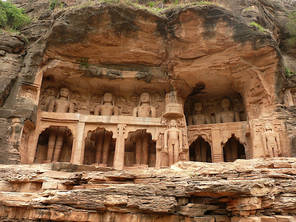
Jinas at Gwalior
Image by Werner Van Der Cruyssen © CC BY-NC-ND 3.0
In Madhya Pradesh Digambara Jains are more prominent. They have left their imprint in several sacred sites of historical importance, as monuments and archaeological remains show.
Khajuraho and Deogarh have a special significance with regard to the history of art and architecture from the ninth century onwards.
Gwalior is known for its gigantic statues of Jinas carved in the stone of the fort. In particular, it demonstrates a glamorous Jain presence in the 15th century, thanks to the combined impact of Jain mendicant communities, literary figures such as Raïdhū and royal patronage.
Mahavirji, Sonagiri and Shivpuri are examples of three smaller sites that have gained wider exposure in recent times.
Maharashtra

Mukta-giri temple-city
Image by mAhEsH bAseDiA – Mahesh Basedia © CC BY-NC-SA 2.0
In this central Indian state the main Jain sacred places are chiefly Digambara. Among the many sites of religious importance in Maharashtra are Ellora, Karanja and Muktagiri.
The site of Ellora with its ancient Jain caves is an old site with important archaeological remains. The cave temples and their surrounds demonstrate rock-carvings and elaborate architecture.
In contrast, places such as Karanja and Muktagiri are living holy places with famous temples.
South India
According to the Jain tradition, a 12-year-long famine led to the migration of part of the community to southern India in the third century BCE. It is said to have been led by Bhadrabāhu, the religious teacher, and the Maurya emperor, Candragupta. Reaching the area corresponding to modern Karnataka, they are believed to have ended their lives by performing the ritual of fasting unto death on the Candra-giri at Śravaṇa Beḷgoḷa.
In Karnataka, Tamil Nadu and, to a lesser extent, in Kerala, there are long-settled Digambara communities. The numerous holy places in these regions signal their presence as far back as the first centuries BCE.
The main holy sites that are still thriving and attracting pilgrims, in particular on the occasion of festivals, are:
- Shravana Belgola in Karnataka
- Mudabidri in Karnataka
- Humcha in Karnataka
- Gommatagiri in Karnataka
- Melsittamur in Tamil Nadu
- Ponnur in Tamil Nadu.
Numerous other sites that have now fallen out of use were prestigious at one time, as various remains show. Examples include Sirudkadumbur and Valathy in Tamil Nadu, which feature rock-beds with inscriptions where Jain ascetics ended their lives by fasting to death. The rocks are often engraved with inscriptions and Jina images. There is a plethora of caves where ascetics stayed in retreat, which are also sculpted with Jina images. Aihole and Badami in Karnataka are famous examples of such sites. Finally, there are abundant temples in south Indian style to be found in the area. Famous ones include the Karnataka sites of Pattadakal, Hampi, Humcha and Moodbidri while Melsittamur is the best known in Tamil Nadu.
Age and identification of holy places
Being rooted in the past is a determining factor in the definition of Jain sacred places. A recurring concern in Jain guidebooks, whether older or modern, is to establish the connection between the traditional name of a holy site and its actual location. This is not an easy task because names may have changed in the course of time.
From the late 19th century onwards the age of holy sites became an issue in India, parallel to progress in excavations and archaeology. For contemporary Jains it has become politically and culturally important to stress that their tradition is both old and distinct and that they form a separate community within Indian society. The dominance of various religious groups in India in different periods means that Jains have always had to struggle to be heard. Archaeological remains are proof of the antiquity of the distinct Jain identity.
Jains and Hindus
It is interesting to note that several Jain holy places of antiquity are also names of well known early historical and religious centres, quite apart from their association with Jainism. Some of them, like Banaras and Ayodhyā, have been known as Hindu holy spots from the earliest times. It is likely that the Jains were keen on establishing a connection with them to claim their place as ‘an ancient component of the north Indian religious environment’ (Dundas 2002: 220).
Archaeological findings and historical sources show how several sites have not been associated with one religious community for eternity. They may have changed hands or were used simultaneously by different faiths.
One example is Mount Abu in southern Rajasthan, a Jain holy place from the 11th century onwards. These Jain associations were preceded by a Hindu presence. In fact Mount Abu was known as a place where a ceremony for the Hindu Rajput class was held. The story in the chronicles of the Kharatara-gaccha, a Śvetāmbara monastic order present in western India from the 12th century onwards, points to competition between religions. A Jain religious teacher found an image of the Jina Ṛṣabhanatha or Lord Ṛṣabha by the temple dedicated to the local Hindu goddess Arbudā. This was the justification for a Jain temple but the local Hindus allowed this only after the Jains paid them for land on which to build the temple (Dundas 2002: 221). Such stories show how both Hindus and Jains had claims to the place and how such potential conflicts could be resolved.
Jains and Muslims
In the medieval period, there are numerous accounts of how Jain images, temples and thus sacred places were destroyed by Muslim persecutions. Many Jain images were buried or hidden in the underground chambers of temples to save them from the iconoclasts. The later rediscovery of such images offered chances to take back holy places into Jain control.
The 14th-century author Jinaprabha-sūri narrates how he played a role in returning an image of Mahāvīra to its original setting. Kept in the sultan’s treasury, the idol was moved to Kanyānayā, which then became a sacred place for the Jains once again.
When Jain temples were converted into Muslim buildings the corresponding tīrthas fell into disuse.
Ownership of holy places
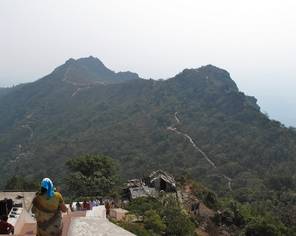
Pilgrims at Mount Sammeta
Image by Deeeep – Deepak Mehta © CC BY-NC 2.0
Some holy places are more or less recognised as predominantly Śvetāmbara, such as Shatrunjaya, while others are accepted as Digambara, such as Shravana Belgola. Other sites are claimed by both sects, but the two groups focus on different parts of the place and on distinct religious manifestations in what can be regarded as productive competition. An example of this is Hastinapur, not far from Delhi. Here, Digambaras concentrate on events centring on the large model of Jambū-dvīpa while Śvetāmbaras focus on the celebration of Akṣya-tṛtīyā and other festivals in their own temples.
However, the ownership of holy places is often a burning issue, where Digambara and Śvetāmbara rivalries burst out. Sometimes this takes on a public dimension that spills over the boundaries of the whole Jain community, as each party calls politicians to its side. This is a source of embarrassment and a topic rather difficult to investigate, but it is echoed in the Jain newspapers.
Well over one hundred sectarian disputes regarding control of religious sites have become public to the wider Indian population. The best-known cases are:
- Bāhubali Hill, near Kolhapur in south Maharashtra in the 1980s (Carrithers 1988), which the Digambaras claimed
- the shrine at Śirpur in Maharashtra, in connection with the image known as Antarīkṣa Pārśvanātha – ‘Floating Pārśva’ – (Dundas 2002: 53–54), which the Śvetāmbaras claimed
- legal actions over Mount Sammeta.
Management of sacred places
In its smallest form a sacred place comprises a small shrine, a temple or any memorial. But in many cases, Jain holy places are vast complexes of several elements:
- clusters of temples
- rest-houses – dharma-śālas – for pilgrims
- eating hall for pilgrims – bhojana-śālās.
These buildings may be next to each other or may be completely separate. In Shatrunjaya or Shravana Belgola, for instance, the temple-city or the Bāhubali statue that are the main focus of pilgrimage are on top of hills where it is forbidden to stay overnight. The villages at the foot of the hill are therefore the places where pilgrims stay.
Prominent holy places such as these, or even more important ones, demand proper, permanent organisation to accommodate the crowds according to Jain principles and values. This presupposes proper, and sometimes rather strict, management, which is generally achieved by private trusts or foundations of varying sizes. One of the most powerful is the Ānandji Kalyānji nī peḍhī. Established around 1730, it controls several major Śvetāmbara holy places, including Shatrunjaya, Girnar and Hastinapur.
In small and secluded places pilgrims receive accommodation and food free of charge, as was the custom. It is understood that the pilgrims will make some donation in exchange. But the larger the place the more regulated arrangements are. These days regular payments for food and lodging are instituted more frequently. A sign of the development of holy places is the number and wide range of rest-houses available. The luxurious ones expected by many modern Jains used to urban comforts are often found side by side with very simple facilities.
New holy places
Jains consider the creation of new sacred places as a manifestation of their presence and dynamism in India. In areas where they are numerous, they invest a lot of money in the erection of new temples, which become the focus of new holy places. This may be observed not just in India but in places around the world where the Jain diaspora has settled in some numbers.
Where the site owes its sanctity to the birth or death of a religious teacher, the connection with the past that is so essential in making a place holy clearly exists. Examples are Ladnun in Rajasthan and the Vallabh Smarak near Delhi.
Even so, there are holy places that are totally new. Mostly, their construction is motivated by a Jain mendicant, who asks his followers to invest in it and thus marks his presence. A recent example is that of Ayodhyapuram in Vallabhipur, in Gujarat, on the road from Ahmedabad to Bhavanagar. The temple here has a distinctly new shape. The main novelty is a gigantic seated statue of Ṛṣabhanātha or Lord Ṛṣabha, measuring seven metres tall and weighing 350 tonnes. Even in this case, a link with the past is claimed – the idea is to present the first Jina with the physical measurements given in the scriptures.
This is just one instance of the unfolding map of Jain geography. Increasing numbers of holy places in the 20th and 21st centuries show the unlimited creativity of Jains in finding new means to assert their presence in the Indian environment and beyond. Jains living outside India must reconcile the old with the new. Creating brand-new religious spaces requires strategies that do not necessarily connect a tīrtha with a Jina‘s life, but find other ways of making a place holy.
Reading
- ‘Understanding Possession in Jainism: A Study of Oracular Possession in Nakoda’
Knut Aukland - Modern Asian Studies
edited by Joya Chatterji
volume FirstView
Cambridge University Press; July 2012
- ‘Recent Developments in a Jaina Tīrtha: Hastināpur (U.P.): A preliminary report’
Nalini Balbir - The History of Sacred Places in India as Reflected in Traditional Literature: Papers on Pilgrimage in South Asia
edited by Hans Bakker
Panels of the VIIth World Sanskrit Conference series; volume III
E. J. Brill; Leiden, Netherlands; 1990
- Jainism in Tamilnadu
Nalini Balbir, Karine Ladrech and N. Murugesan and K. Ramesh Kumar - Institut Français de Pondichéry; Puducherry, India; forthcoming
- Organizing Jainism in India and England
Marcus Banks - Oxford Studies in Social and Cultural Anthropology series; volume 3
Clarendon Press; Oxford, UK; 1992
- ‘Historical Consciousness in Theravāda Buddhism and Śvetāmbara Jainism at the Turn of the Century and its Impact on the Attitude to Places of Religious and Historical Significance’
Torkel Brekke - Jainism and Early Buddhism in the Indian Cultural Context: Essays in Honor of Padmanabh S. Jaini
edited by Olle Qvarnström
Asian Humanities Press; Fremont, California, USA; 2003
- The Temples of Śatruñjaya: the Celebrated Jaina Place of Pilgrimage, near Pālitāṇā in Kathiawad
James Burgess - Gujarat State Committee for the celebration of 2500th Anniversary of Bhagwan Mahavira Nirvan; Gandhinagar, Gujarat, India; 1976
- ‘Passions of Nation and Community in the Bahubali Affair’
Michael Carrithers - Modern Asian Studies
volume 22: 4
Cambridge University Press; 1988
- ‘Monts sacrés et alchimie jaina au Moyen Age: L’Ujjayantakalpa de Jinaprabhasūri’
Christine Chojnacki - Vividharatnakaraṇḍaka: Festgabe für Adelheid Mette
edited by Christine Chojnacki, Jens-Uwe Hartmann and Volker M. Tschannerl
Indica et Tibetica series; volume 37
Indica et Tibetica; Swisttal-Odendorf, North-Rhine-Westphalia, Germany; 2000
- Jains in the World: Religious Values and Ideology in India
John E. Cort - Oxford University Press USA; New York, USA; 2001
- The Jains
Paul Dundas - Library of Religious Beliefs and Practices series; series editor John Hinnels and Ninian Smart; volume 14
Routledge Curzon Press; London, UK; 2002
- ‘Medieval Jain Accounts of Mt. Girnar and Satrunjaya: Visible and Invisible Sacred Realms’
Phyllis Granoff - Journal of the Oriental Institute
volume XLIX: 1–2
Baroda, Gujarat, India; 1999
- Victorious Ones: Jain Images of Perfection
Phyllis Granoff - Mapin Publishing Pvt. Ltd and Rubin Museum of Art, New York; Ahmedabad, Gujarat, India and New York, USA; 2009
- ‘Creating Sacred Space in Medieval Jainism: Some Case Studies’
Phyllis Granoff - Journal Asiatique
volume 297: 2
Peeters; 2009
- Re-Formation of Identity: The 19th-century Jain Pilgrimage Site of Shatrunjaya, Gujarat
Kim Hawon Ku - PhD dissertation submitted to University of Minnesota in March 2007
- Jaina Temple Architecture in India: The Development of a Distinct Language in Space and Ritual
Julia A. B. Hegewald - Monographien zur Indischen Archäologie, Kunst und Philologie series; volume 19
Stiftung Ernst Waldschmidt, G+H Verlag; Berlin, Germany; 2009
- Vividhatīrthakalpa
Jinaprabhasūri - edited by Muni Jinavijaya
Singhi Jain series; volume 10
Shantiniketan; Bombay, India; 1934
- ‘The Pilgrimage to Shatrunjaya: Refining Shvetambara Identity’
Andrea Luithle-Hardenberg - An Anthropology of Values – essays in honour of Georg Pfeffer
edited by Peter Berger, Roland Hardenberg, Ellen Kattner and Michael Prager
Pearson Longman; Delhi, India; 2010
- ‘The “99fold“ pilgrimage to Shatrunjaya: A case study of young women’s embodiment of Jaina tradition’
Andrea Luithle-Hardenberg - Svasti – essays in honour of Prof. Hampa Nagarajaiah
edited by Nalini Balbir
Muddushree Granthamala series; volume 75
K. S. Muddappa Smaraka Trust; Bangalore, Karnataka, India; 2010
- Śrāddhavidhiprakaraṇa
Ratnaśekhara-sūri - Śreṣṭhi-Devacanda-Lālbhāī-Jaina Pustakoddhara Fund series; volume 106
Surat, Gujarat, India; 1960
- Treasures of Jaina Bhandāras
Umakant Premanand Shah - L. D. series; volume 69
L. D. Institute of Indology; Ahmedabad, Gujarat, India; 1978
- Paṭadarśana (Tīrthaṃkara praṇīta dharmadeśanā antargata Śatruṃjaya māhātmya): The glory of Shatrunjaya as depicted in a 19th Century Jain scroll
Kalpana K. Sheth and Nalini Balbir - Jain Vishva Bharati University; Ladnun, Rajasthan, India;
- Travels in Western India: embracing a visit to the sacred mounts of the Jains and the most celebrated shrines of Hindu faith between Rajpootana and the Indus, with an account of the ancient city of Nehrwalla
James Tod - Munshiram Manoharlal; New Delhi, India; 1997
- Steps to Liberation: 2500 Years of Jain Art and Religion
Jan van Alphen - Etnografisch Museum Antwerpen; Antwerp, Belgium; 2000
- Historical Dictionary of Jainism
Kristi L. Wiley - Historical Dictionaries of Religions, Philosophies, and Movements series; series editor Jon Woronoff; volume 53
Scarecrow Press; Maryland, USA; 2004
- Jaina Yoga: A Survey of the Mediaeval Śrāvakācāras
Robert Williams - London Oriental series; volume XIV
Oxford University Press; London, UK; 1963
Links
- Types of Jain holy sites
-
Shugan Chand Jain classifies Jain holy sites in this excerpt from his piece entitled 'Jain Festivals (Parva) and Jain Pilgrimage (Teerth yatra)-(B) Pilgrimage'. It forms part of the study notes offered by the International School for Jain Studies in 2009.
This extract was published on HereNow4U.net in 2008.
- List of Digambara holy places
-
Jainteerth.com provides a list of Digambara holy places in India, complete with details of the main temple and idol, location, travel information, facilities for pilgrims and contact details of the management organisation. The site also offers background information on temples and Jain principles. Unfortunately, the standard of English is not very good.
- James Tod biography
-
An officer in the British East India Company, James Tod (1782–1835) published extensive accounts of the history and geography of India, including details of his travels in Gujarat and Rajasthan between 1819 and 1823. This entry from volume 56 of the Dictionary of National Biography (1885–1900) appears in Wikisource.
- Views of the temples at Mount Girnar
-
Collection of photographs of the temples found at Mount Girnar. The 22nd Jina, Neminātha or Lord Nemi, is closely associated with Mount Girnar, having renounced the world, gained omniscience and then final liberation here. There are 16 Jain temples on the site, which is sacred to both Jains and Hindus. These photographs are presented by Professor Frances W. Pritchett of Columbia University in New York.
http://www.columbia.edu/itc/mealac/pritchett/00routesdata/1000_1099/jaintemples/girnar/girnar.html
- Nandīśvara-dvīpa brass sculpture
-
This freestanding brass sculpture depicts the mythical continent of Nandīśvara, where the gods go to perform religious duties. Depictions of Nandīśvara-dvīpa are frequently worshipped among the Digambara sect, but a metal image is rare. The sculpture features 52 Jinas, both sitting and standing. This piece of art is described as part of a lot auctioned by Christie's in 2002.
- Past images of Mount Abu
-
Historical photographs and drawings of Mount Abu, a famous Jain pilgrimage site boasting white marble temples with ornate carvings. These images are presented by Professor Frances W. Pritchett of Columbia University in New York.
- Views of the temple at Ranakpur
-
One of the foremost Śvetāmbara pilgrimage sites, the main temple at Ranakpur has around 1,400 intricately carved marble columns. This collection of photographs of the Ādinātha temple at Ranakpur in Rajasthan is presented by Professor Frances W. Pritchett of Columbia University in New York.
- Francis Buchanan biography
-
This Wikipedia entry profiles Francis Buchanan (1762–1829), who carried out extensive surveys of southern and north-eastern India during the British East India company's expansion into India.
- Seven Wonders of India – Palitana Temples
-
The Svetāmbara pilgrimage centre at Mount Shatrunjaya is showcased in this NDTV video on YouTube. Jain pilgrims are shown climbing the steep hill – some carried in a kind of palanquin called a ḍolī – and worshipping in some of the hundreds of temples on the twin hills. The presenter gives a brief outline of the Jain faith and mentions the navanū – ‘99fold’ – pilgrimage, which is one of the hardest and most demanding ones.
Beginning in 2008, the New Delhi Television show Seven Wonders of India asked viewers to vote for their favourite seven sites in the country over a year. Part of a publicity campaign organised by the Ministry of Tourism, the show's presenters visited many sites considered potential winners.
- Views of Shatrunjaya temples
-
Collection of photographs of the temple-city of Mount Shatrunjaya. The pre-eminent Śvetāmbara pilgrimage site, Shatrunjaya has nearly a thousand temples. The main temple is dedicated to Ṛṣabha, the first Jina, often called Ādinātha or First Lord. These photographs are presented by Professor Frances W. Pritchett of Columbia University in New York.
- Views of temples at Mukta-giri
-
The Digambara temple-city of Mukta-giri has 52 temples. Found in Madhya Pradesh, this popular pilgrimage attraction is built in a valley instead of on a high place more usual for holy sites. These images are presented by Professor Frances W. Pritchett of Columbia University in New York.
- Views of pilgrimage site of Gwalior
-
Photographs of Gwalior in Madhya Pradesh, including details of interior architecture and the numerous large statues of Jinas for which the site is famous.
Provided by the World Art Treasures, the Fondation Jacques-Edouard Berger in Lausanne, Switzerland.
(Input Gwalior in Madhya Pradesh in Search)
- Colin Mackenzie biography
-
This Wikipedia article on Colin Mackenzie (1753–1821) summarises his career. As the first Surveyor General of India under early British colonial rule, he supervised detailed investigations into Indian architecture, especially in southern India.
- Introduction to Shravana Belgola
-
This audio slideshow on YouTube introduces the pilgrimage centre of Shravana Belgola in Karnataka. Sacred to the Digambara sect in particular, Shravana Belgola is dedicated to Bāhubali, also called Gommaṭeśvara or ‘Lord of Gommaṭa’. The site is found on the twin hills of Vindhya-giri and Candra-giri, with a large reservoir and the town between them. The centre of the site is the 18-metre-tall statue of Bāhubali on Vindhya-giri. This slideshow was uploaded by Boltell in 2010.
- Worship at Shravana Belgola
-
This short 2009 video films a worship ceremony – pūja – at the pilgrimage site of Shravana Belgola in Karnataka. The temple attendants perform the daily ritual bath – mastakābhiṣeka – on the small metal idol at the bottom of the 18-metre-high statue of Bāhubali, also called Gommaṭeśvara or ‘Lord of Gommaṭa. They trickle water on to the feet of the stone colossus and offer it to worshippers because the water is believed to have special properties after it has been used in the ceremony. The grand version of the rite – Mahā-mastakābhiṣeka or ‘Great head-anointing ceremony’ – is one of the most spectacular Jain festivals and takes place every 12 years, drawing thousands of pilgrims and sightseers. ifredpr uploaded this video to YouTube in 2011.
- Seven Wonders of India – Shravanabelagola
-
The Digambara pilgrimage site of Shravana Belagola in Karnataka is the subject of this NDTV video on YouTube. The presenter gives a brief history of the site and the story of Bāhubali, whose huge statue is the focus of worship. Some pilgrims in ill health are carried in sedan chairs up and down the steep hill, atop which stands the Bāhubali colossus. Inscriptions protected by heavy sheets of glass are shown. Pilgrims performing worship rituals are filmed, including the sacred bath or ‘head-anointing ceremony’ – mastakābhiṣeka – of a small metal image of Gommaṭeśvara or Bāhubali.
The New Delhi Television show Seven Wonders of India asked viewers to vote for their favourite seven sites in the country. It was part of a publicity campaign organised by the Ministry of Tourism in 2008 to 2009. The show's presenters visited many sites considered potential winners.
- Jaina temples of Tamil Nadu
-
A scholarly project researching the Jain temples of Tamil Nadu, investigating worship rituals and celebrations in addition to the architecture, art and inscriptions of the buildings. Led by the French Institute of Pondicherry, the project will be published as a CD-ROM.
- Ayodhyapuram temple
-
This 2009 photo on Flickr shows the recently built temple of Ayodhyapuram in Vallabhipur in Gujarat, which is dedicated to R̥ṣabha. Taking an innovative design, the temple houses a very large statue of the first Jina in the lotus position, which weighs around 23 tonnes.
- Marianne North biography
-
This page on Answers.com gives detailed information about the life and career of Marianne North (1830–1890). A British painter famous for lifelike paintings of plants and flowers, North also painted landscapes during 13 years of global travel, spending 1877 to 1878 in India.
- Paṭa of Mount Shatrunjaya
-
A 19th-century Rajasthani example of a paṭa – decorative map of a holy site – of the pilgrimage centre of Mount Shatrunjaya. Owned by the Philadelphia Museum of Art in the United States, the paṭa can be enlarged by clicking on the icon of the magnifying glass. A paṭa can be used to complete a mental pilgrimage to the place depicted, which is believed to be of even more religious value than making the physical journey.
http://www.philamuseum.org/collections/permanent/68189.html?mulR=31553|11
- +
- aAbhavya
- aAbhinandana
- aAbhiṣeka
- aĀcāra
- aĀcārāṅga-sūtra
- aĀcārya
- aAchalbhrata
- aAḍhāī-dvīpa
- aAdharma
- aAdho-loka
- aAdhyayana
- aAdvaita Vedānta
- aĀgama
- aAghātīya
- aAghātīya-karman
- aAgnibhuti
- aAgra
- aĀhāra
- aAhiṃsā
- aAhimsa Day
- aAjita
- aAjīva
- aAkampit
- aĀkāśa
- aAkbar the Great
- aAkṣaya-tṛtīyā
- aAlauddin Khalji
- aAlbert Einstein
- aAllah
- aAlms
- aĀlocanā
- aAloka-ākāśa
- aAmāri
- aAmbikā or Kūṣmāṇḍinī
- aAnagāra
- aAnanta
- aAnarthadaṇḍa
- aAnaśana
- aAnekānta-vāda
- aAṅga
- aAniconism
- aAnojjā
- aAntarāla
- aAntarāya-karma
- aAṇu
- aAṇu-vrata
- aAnukampā
- aAnuprekṣā
- aAnusvāra
- aApabhraṃśa
- aAparigraha
- aAra
- aĀrambha
- aĀrambhaja
- aĀratī
- aArdhamāgadhī Prākrit
- aArhaṃ
- aArhat
- aArśana-āvaraṇīya-karma
- aĀrta-dhyāna
- aĀryikā
- aĀryikā Jñānamati
- aĀśātanā
- aĀścarya
- aAscetic
- aAsceticism
- aAshram
- aAspiration
- aĀsrava
- aAṣṭa-maṅgala
- aAṣṭāpada
- aAstikāya
- aAstrolabe
- aAsura
- aAtheism
- aAticāra
- aAtiśayakṣetra
- aAtithisaṃvibhāgavrata
- aĀtma-vāda
- aĀtman
- aAuṃ
- aAurangzeb
- aAuspicious
- aAusterity
- aAvadhāna
- aAvadhi-jñāna
- aĀvaraṇī-yakarman
- aAvasarpiṇī
- aAvatāra
- aAvidyā
- aAxiom
- aĀyāga-paṭa
- aĀyambil
- aĀyu-karma
- aĀyurveda
- bBabur
- bBāhubali
- bBaladeva
- bBālāvabodha
- bBandha
- bBasadi
- bBazaar
- bBhadrankarvijay
- bBhagavant
- bBhaktāmara-stotra
- bBhakti
- bBhale
- bBharata
- bBhāṣā
- bBhāṣya
- bBhaṭṭāraka
- bBhāva
- bBhāva-pūjā
- bBhāvanā
- bBhavana-vāsin
- bBhavya
- bBhavyatva
- bBhaya
- bBhoga-bhūmi
- bBhogopabhoga
- bBodhi
- bBollywood
- bBrahmā
- bBrahma-deva
- bBrahmacārī
- bBrāhmaṇa
- bBraj Bhāṣā
- bBright fortnight
- bBritish Raj
- bBuddha
- bBuddhi-sagar
- bBuddhism
- bBuddhist
- cCaitya
- cCaityavāsin
- cCakravartin
- cCakreśvarī
- cCāmara
- cCandanā
- cCandragupta
- cCandraprabha
- cCanon
- cCāritra
- cCāritramohanīya-karman
- cCarũrī
- cCaste
- cCaturvidha-saṅgha
- cCaturviṃśati-stava
- cCāturyāma
- cCE
- cCelibacy
- cCha
- cChadmastha
- cChastity
- cCheda-sūtra
- cChristian
- cChristianity
- cClergy
- cCloning
- cColophon
- cCommentary
- cConch
- cConfession
- cCongregation
- cConsecration
- cCosmology
- cCremation
- cCrore
- cCult
- cCūrṇi
- dDādā-guru
- dDalit
- dDāna
- dDaṇḍa
- dDark fortnight
- dDarśana
- dDarśanamohanī-yakarman
- dDaśa-lakṣaṇa-parvan
- dDeity
- dDelhi Sultanate
- dDerāsar
- dDeśāvakāśika-vrata
- dDetachment
- dDevanāgarī
- dDevānandā
- dDevarddhi-gani
- dDevotee
- dDhamal
- dDhanuṣ
- dDhāra
- dDharma
- dDharma-dhyāna
- dDharma-sāgara
- dDharmastikaya
- dDhātakīkhaṇḍa
- dDholak
- dDhyāna
- dDiaspora
- dDig-vrata
- dDigambara
- dDīkṣā
- dDisciple
- dDīvālī
- dDivya-dhvani
- dDNA
- dDoctrine
- dDogma
- dDonor
- dDoṣa
- dDravya
- dDravya-pūjā
- dDrone
- dDuṣamā
- dDuṣamā-duṣamā
- dDuṣamā-suṣamā
- dDveṣa
- dDvīpa
- eEast India Company
- eEightfold Path
- eEkānta-vāda
- eEkendriya
- eElder
- eElders
- eEschatology
- eEtc up to
- fFarmān
- fFast
- fFatehpur Sikri
- fFestival
- fFestschrift
- fFiruz Shah
- fFly-Whisks
- fFolio
- fFour Noble Truths
- gGaccha
- gGaṇa
- gGaṇadhara
- gGanadharavada
- gGaṇeśa
- gGaṇin
- gGarba
- gGarbha
- gGarbha-gṛha
- gGaruḍa
- gGati
- gGene
- gGenomics
- gGhātī-yakarman
- gGhātīya
- gGhaznavid
- gGhiyasuddin Tughlaq
- gGhurid
- gGloss
- gGotra-karma
- gGujarāt
- gGujarati
- gGuṇa
- gGuṇa-sthāna
- gGuṇa-vrata
- gGupti
- gGuru
- gGuruṇī
- hHagiography
- hHajj
- hHaṃsa
- hHaribhadra
- hHariṇaigameṣin
- hHasta
- hHeresy
- hHiṃsā
- hHindi
- hHindu
- hHinduism
- hHīravijaya
- hHoroscope
- hHrīṃ
- hHumayun
- hHymn
- iIconoclasm
- iIconography
- iIdol
- iIndian Independence
- iIndology
- iIndra
- iIndrabhūti Gautama
- iIndriya
- iInitiation
- iIntercession
- iInvocation
- iIQ
- iIslam
- iIslamicate
- iIṣṭadevatā
- iĪśvara
- jJagat
- jJahangir
- jJain
- jJaina Devanāgarī
- jJaina Śaurasenī
- jJaina-dharma
- jJainaśāsana
- jJainness
- jJaisalmer
- jJamāli
- jJambū-dvīpa
- jJames Burgess
- jJanma
- jJanma-kalyāṇa
- jJarā
- jJāti
- jJina
- jJina-āgama
- jJina-bhavana
- jJina-bimba
- jJina-mātā
- jJinacandra-sūri
- jJinadatta
- jJinaprabha
- jJīva
- jJñāna
- jJñāna-āvaraṇīya-karma
- jJñāna-āvarṇiya
- jJñānsundar
- jJyotiṣka
- kKāla
- kKālakācārya-kathā
- kKālidāsa
- kKalpa-sūtra
- kKalpa-vṛkṣa
- kKalyāṇaka
- kKalyanvijay
- kKamaṇḍalu
- kKamaṭha
- kKarma
- kKarma-bhūmi
- kKarma-grantha
- kKarma-prakṛti
- kKarma-vāda
- kKarmon
- kKarnataka
- kKaṣāya
- kKathā
- kKāvya
- kKāya
- kKāyotsarga
- kKeśa-loca
- kKetu
- kKevala-jñāna
- kKevalin
- kKhalji
- kKharatara-gaccha
- kKnowledge
- kKriyā
- kKriyā-vāda
- kKṛṣṇa
- kKṣamā-śramaṇa
- kKṣapakaśreṇi
- kKṣatriya
- kKṣullaka
- kKulakara
- kKundakunda
- kKunthu
- lLabdhi
- lLaity
- lLakh
- lLāñchana
- lLands of Action
- lLaukāntika
- lLavaṇa-samudra
- lLeśyā
- lLiṅga
- lLinguistics
- lLoka
- lLoka-ākāśa
- lLoka-puruṣa
- lLoka-vāda
- lLotus
- lLotus lake
- mMadhya-loka
- mMahā-videha
- mMahā-vrata
- mMahābhārata
- mMahāmastakābhiṣeka
- mMāhārāṣṭra
- mMāhārāṣṭrī Prākrit
- mMahattarā Yākinī
- mMahāvīr Jayantī
- mMahāvīra
- mMakāra
- mMakkhali Gośāla
- mMalli
- mMāna-stambha
- mManaḥ-paryāya-jñāna
- mMaṇḍala
- mMaṇḍapa
- mMandit
- mMaṅgala
- mMantra
- mMantras
- mManuṣya-loka
- mMarāṭhī
- mMārgaṇā
- mMartyr
- mMarudevī
- mMaṭha
- mMati-jñāna
- mMauryaputra
- mMecca
- mMendicant lineage
- mMetarya
- mMiracle
- mMithyādṛṣṭi
- mMohandas Gandhi
- mMohanīya-karma
- mMokṣa
- mMonastic order
- mMonasticism
- mMonk
- mMonotheism
- mMosque
- mMount Meru
- mMount Sammeta
- mMṛgāvatī
- mMughal
- mMuhammad
- mMuhammad bin Tughlaq
- mMuhpattī
- mMūla-sūtra
- mMūlaguṇa
- mMumbaī
- mMuni
- mMunisuvrata
- mMurad Bakhsh
- mMūrti-pūjaka
- mMuslim
- mMysticism
- nNābhi
- nNāga-kal
- nNāgapurīya Tapā-gaccha
- nNāgarī
- nNāma-karma
- nNamaskāra-mantra
- nNami
- nNandīśvara-dvīpa
- nNandivardhana
- nNandyāvarta
- nNāraka
- nNāraki
- nNasalisation
- nNātha
- nNavrātrī
- nNaya-vāda
- nNemi
- nNidāna
- nniggaṃthāṇa vā 2
- nniggaṃtho vā 2
- nNigoda
- nNihnava
- nNikṣepa
- nNirgrantha
- nNirjarā
- nNirvāṇa
- nNiryukti
- nNiṣidhi
- nNitya
- nNiyati
- nNo-kaṣāya
- nNudity
- nNun
- oOcean of milk
- oOmniscience
- oOrdination
- ppa°
- pPadmaprabha
- pPadmāsana
- pPadmāvatī
- pPādukā
- pPalanquin
- pPalette
- pPañca-muṣṭi
- pPāṇḍava
- pPaṇḍit
- pPandit Dalsukh D. Malvania
- pPandit Sukhlalji
- pPāṇipātra
- pPāpa
- pParamātman
- pParameṣṭhin
- pPāraṇā
- pParigraha
- pPariṇāma
- pParīṣaha
- pParokṣa
- pPārśva
- pPārśvanātha
- pParyāya
- pParyuṣaṇ
- pPaṭa
- pPatan
- pPātra
- pPenance
- pPersian
- pPhala
- pPhilology
- pPicchikā
- pPilgrimage
- pPīr
- pPolymath
- pPoṣadha
- pPossession
- pPothī
- pPrabhas
- pPradakṣiṇā
- pPradeśa
- pPrākāra
- pPrakīrṇaka-sūtra
- pPrākrit
- pPramāda
- pPramukhā
- pPrati-vāsudeva
- pPratikramaṇa
- pPratimā
- pPratiṣṭhā
- pPratyākhyāna
- pPratyakṣa
- pPravacana
- pPrāyaścitta
- pPrayer
- pPre-modern
- pPreach
- pPredestination
- pProtestant
- pProvenance
- pPudgala
- pPūjā
- pPujārī
- pPukharavara-dvīpa
- pPuṇya
- pPūrva
- pPuṣkara-dvīpa
- pPuṣpadanta
- pPyre
- qQur’an
- rRāga
- rRāhu
- rRainy season
- rRajasthan
- rRajasthani
- rRājimatī
- rRajoharaṇa
- rRajput
- rRāma
- rRāmāyaṇa
- rRangoli
- rRās-garbā
- rRasa
- rRathanemi
- rRatna-traya
- rRātri-bhojana
- rRaudra-dhyāna
- rRecto
- rRelic
- rRenunciation
- rRetroflex
- rRevatī
- %Ṛg-veda
- rRite
- rRosary
- %Ṛṣabha
- %Ṛṣabhanātha
- rRupee
- sSaciyā Mātā
- sSādhu
- sSādhvī
- sSāgāra
- sSaint
- sŚaivaism
- sŚaka-saṃvat
- sSallekhanā
- sŚalya
- sSamacatuṣṭha
- sSamādhimaraṇa
- sSamaṇi
- sSāmarambha
- sSamavasaraṇa
- sSāmāyika
- sSaṃbhava
- sSamiti
- sSaṃjñā
- sSaṃkalpaja
- sSaṃsāra
- sSamudghāta
- sSaṃvara
- sSaṃvega
- sSamyak-cāritra
- sSamyak-darśana
- sSamyak-jñāna
- sSamyaktva
- sSaṃyama
- sSanctuary
- sSandalwood
- sSaṇgha
- sSanskrit
- sSant
- sŚānti
- sSapta-bhaṅgi-naya
- sSārambha
- sSarasvatī
- sSarvajña
- sSāsan-devi
- sŚāsana-devatā
- sŚāstra
- %Ṣaṭ-jīvanikāya
- sSatī
- sSatīmātā
- sSatya
- sSchism
- sScribe
- sScripture
- sSect
- sSecularism
- sŚenāī
- sSermon
- sŚeṣavatī
- sSevā
- sSeven fields of donation
- sShah Jahan
- sShantidas Jhaveri
- sShrine
- sSiddha
- sSiddha-śilā
- sSiddhacakra or Navadevatā
- sSiddhānta
- sSiddhārtha
- sSiddhi
- sSikh
- sSikhism
- sŚikṣā-vrata
- sŚīla
- sSin
- sSindh
- sŚītala
- sŚiva
- sSkandha
- sSomanatha
- sŚraddhā
- sŚramaṇa
- sŚrāvaka
- sŚrāvakācāra
- sŚrāvikā
- sŚreyāṃsa
- sŚrī
- sŚrīvatsa
- sŚruta-jñāna
- sŚruta-pañcamī
- sSthānaka-vāsin
- sSthāpanācārya
- sSthāvara
- sSthavira
- sSthiti
- sStrīmukti
- sStūpa
- sSubcontinent
- sSudarshana
- sŚuddhi
- sSudharma
- sŚūdra
- sSufism
- sSukha
- sŚukla-dhyāna
- sSulasā
- sSultan
- sSumati
- sSundarśrī
- sSupārśva
- sSūri
- sSuṣamā
- sSuṣamā-duṣamā
- sSuṣamā-suṣamā
- sSūtra
- sSuyam me ausam! Tenam bhagavaya evamakkhayam
- sSvādhyāya
- sSvāhā
- sSvastika
- sŚvetāmbara
- sŚvetāmbara Terāpanthin
- sŚvetāmbaras
- sSwan
- sSyād-vāda
- tTabla
- tTantra
- tTapā-gaccha
- tTapas
- tTāraṇ Svāmī Panth
- tTattva
- tTattvārtha-sūtra
- tTemple
- tTemple-city
- tThe Enlightenment
- tTheology
- tThree worlds
- %Ṭīkā
- tTilaka
- tTīrtha
- tTīrthaṃkaranāma-karman
- tTīrthankara
- tTransliteration
- tTrasa
- tTrasa-nāḍī
- tTriśalā
- tTriṣaṣṭi-śalākā-puruṣa-caritra
- tTti bemi
- tTughlaq
- tTunk
- uUdumbara
- uUniversal History
- uUpādhyāya
- uUpāṅga
- uUpaniṣads
- uUpāsaka
- uUpasarga
- uUpāśraya
- uŪrdhva-loka
- uUtsarpiṇī
- uUttarādhyayana-sūtra
- vVāhana
- vVaimānika
- vVairāgya
- vVaiṣṇava
- vVaiśramaṇa
- vVaiśya
- vValabhī
- vVanaspatikāya
- vVandana
- vVaṇik
- vVarṇa
- vVāsudeva
- vVāsupūjya
- vVayubhūti
- vVeda
- vVedanīya-karma
- vVegetarianism
- vVehicle
- vVernacular
- vVerso
- vVidyā
- vVidyā-devī
- vVihāra
- vVijñapti-patra
- vVikrama-saṃvat
- vVikṛti
- vVimala
- vVinaya
- vVipāka
- vVirji Vora
- vVirodhaja
- vVīrya
- vVisarga
- vViṣṇu
- vVītarāga
- vVizier
- vVotive
- vVow
- vVrata
- vVS
- vVyakta
- vVyantara
- vVyasana
- yYakṣa
- yYakṣī
- yYantra
- yYaśoda
- yYaśovijaya
- yYati
- yYātrā
- yYoga
- yYoginī
- yYojana


